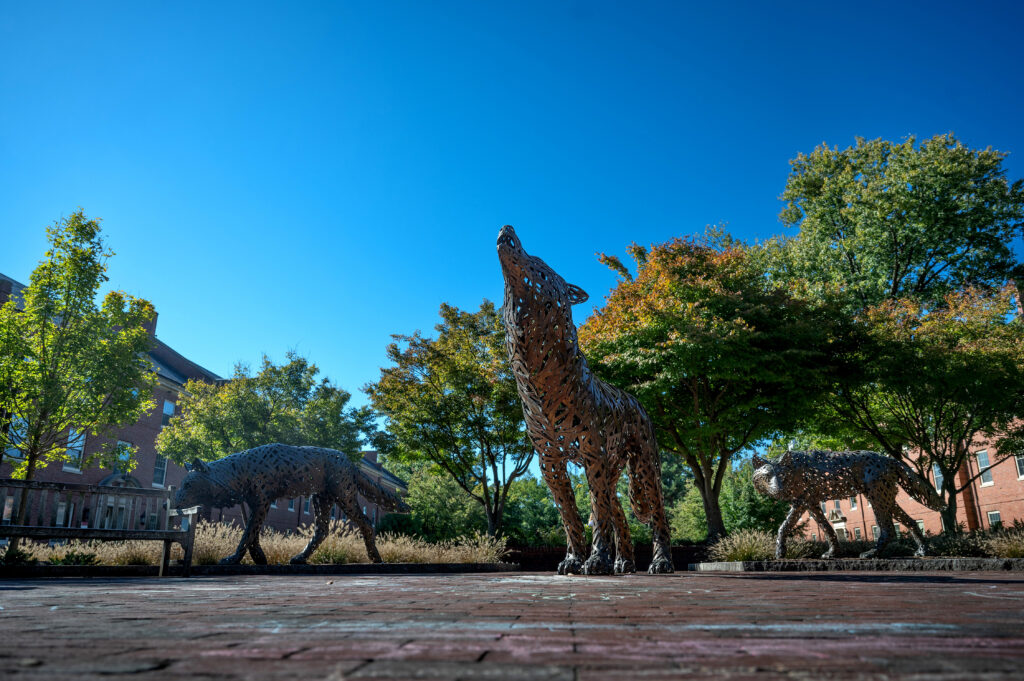Pack Science Challenge 2024

Take a seat and listen. What do you hear?
The Spring 2024 Pack Science Challenge features Sound Around Town, a public science project about human perceptions of outdoor acoustic environments. Help us understand how different acoustic environments affect human well-being by completing listening tasks at multiple campus locations.
WHEN

The Pack Science Challenge takes place March 25 – April 12, 2024. Participate during the day or after dark to help us understand the impact of noise during the day vs night!
WHY

We are seeking to understand how campus soundscapes impact student concentration, mental health, and campus bird diversity!
PRIZES

All participants will receive prizes ranging from stickers to t-shirts. Participate at more stations to earn more points towards prizes (100 points per activity per station).
HOW TO PARTICIPATE
From March 25th – April 12th, find a spot on campus — OR — at one of our ten campus listening stations to provide your input on campus soundscapes, biodiversity, and light pollution. The people who manage our campus physical environment want to know about your experiences of campus soundscapes, so visit as many different places on campus as possible (quiet, loud, peaceful, places you frequent, places you like and don’t like, etc.) to share your perceptions about the sounds you hear with Sound Around Town.

Measure Noise Pollution with Sound Around Town
- Navigate to https://scistarter.org/Sound-Around-Town-home and click the link to participate.
- Follow the instructions on the page to consent to participate.
- Follow the instructions on the page to complete a 5-minute listening session.
If participating at an engagement station, open the door to the box and use the provided decibel meter to report the loudness value when prompted in Sound Around Town. If not participating at a station, you can report your loudness value using the free app “Decibel X”.
How to use Sound Meters
- Reach inside the box to pull out the sound meter.
- Turn on the meter. Allow meter to run for 2 minutes.
- Press the min button to retrieve the minimum value and record in the Sound Around Town form. Press the max button to retrieve the maximum value and record in the Sound Around Town form.
How to Use Decibel X
- Download the app to device from your app store.
- Tap the “Reset” button next to the “Play/Pause” button to reset the timer along with data points.
- Select play to start the audio recording (limit noise made while recording).
- Once two minutes has elapsed, end recording and tap the save button to the right of the play/pause button to save the recording data.
- Tap the Camera button in the bottom left corner to take a picture of yourself to post on Twitter with the hashtag #PackScience for more points!
Ready for more science?
Help us understand how noise and night-sky light impact campus bird diversity by sharing birds you hear using the free Merlin Bird ID app, and reporting the night sky quality with a dark sky quality meter.
Inside each campus listening station, you will find decibel meters for measuring outdoor sound levels and sky quality meters for measuring night-sky light pollution. If you are participating at a location without a station, download Merlin Bird ID and borrow a sky quality meter from Hill Library to participate anywhere on campus. Contribute more observations to earn points towards more prizes.
Sense Bird Diversity with Merlin Bird ID

Merlin Bird ID uses machine learning of spectrograms to identify what birds are singing in your area, with or without cell service. Birds have been shown to help reduce stress and find mental relief. Help us understand how campus soundscapes impact our ability to detect bird diversity.
- Download the Merlin Bird ID in the app store.
- Click “Sound ID” on the home page.
- Point your phone’s microphone away from your body and leave running for 2 minutes. During this time microphone will record the soundscape, detect bird songs, and provide suggestions in real time of any birds singing in the area.
- After the 2-minute period is complete, stop the recording and return to the Sound Around Town form to report the number of birds detected in the appropriate section. If you are at a station, use the provided visual guide inside the box to help you include birds you see at your location.
- Click on the image of the birds you saw or detected using Merlin during your 2-minute survey.
Measure Light Pollution with Sky Quality Meters

How to use Dark Sky Quality Meters
Dark Sky Quality Meters (SQM) use sensors to measure “Luminance”, or the light given off by a surface. Light pollution impacts birds’ ability to navigate at night, which is important during spring and fall migration (March -November). Help us understand how campus night sky quality and light pollution impact bird diversity.
- Return to your sampling location on campus two or more hours after sunset.
- If participating at a station, reach inside the box to pull out the sky quality meter. Sky quality meters can also be checked out at the Ask Us Desk at Hill Library if participating at a location without an engagement station.
- Turn on the device.
- Ensure that the sensor is aimed at the sky. The SQM sensor is on the same side as the display, so you will aim the display at the sky and press and release the button. When the beeping stops, then you can turn the unit towards you to see the reading.
- Input your SQM value into the appropriate place in the Sound Around Town Form.
- To help us understand noise and bird diversity at night, complete another Sound Around Town submission and Merlin Bird ID survey.
Prizes
Did you know you can earn prizes by participating in the Pack Science Challenge? Reach our point milestones to unlock various prizes. The first 100 people to complete listening sessions at all ten campus engagement stations or reach 1500 points will also receive a Pack Science Challenge t-shirt.
Prize Milestones
300 points = small sticker of your choice
900 points = medium sticker of your choice
1500 + points = t-shirt
How can I earn points?
Each task you complete with the Pack Science Challenge is worth 100 points. Complete the following tasks to earn points for larger prizes:
- Complete a listening session at one or more of the 10 engagement stations (100 points each)
- Share your opinion of this year’s challenge and a picture of you completing the project on social media with the hashtag #PackScience (100 points)
- Participate with Merlin Bird ID at one or more of the campus engagement stations (100 points each)
- Complete night sky light pollution surveys at one or more stations (100 points each)
Points will be tallied and prizes distributed at the end of the Challenge on April 12th.
Thank you to this year’s sponsors and collaborators:



Questions? Contact SoundAroundTown@ncsu.edu